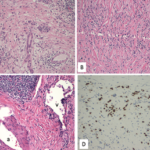Later, he and his team used skin biopsies of a patient who responded well to rituximab to find that, along with B cells, the level of CD4-positive T cells was depleted as well.
We recognize that IgG4-related disease really can involve every single organ in the body.
A particular kind of T cell is especially well represented in IgG4-related disease, which his team has described. It makes interferon gamma, interleukin-1 and transforming growth factor beta, which could drive the disease’s hallmark storiform fibrosis. It also produces perforin, granzyme A and B and granulysin, which can also contribute to disease.
“You can see that central to our understanding of the pathophysiology is this dance between cells of the B cell and the T cell lineage,” he said, with plasmablasts or B cells likely presenting an antigen to the CD4-positive cytotoxic T lymphocyte, Dr. Stone said. The antigen has not been identified yet.
“We think that the IgG4 is an ineffectual attempt to down-regulate the ongoing inflammatory response,” he said. “But this T cell, in turn, is making perforin and granzyme A and B and granulysin and fibrogenic cytokines, driving the fibrosis, which is so characteristic of this disease.”
His team is now doing a clinical trial of a novel molecule, which they hope will lead to treatment as effective as B cell depletion.
“We also look forward to targeting this T cell with specific therapy at some point,” he said, “hopefully in the near future.”
Thomas R. Collins is a freelance medical writer based in Florida.
Reference
- Stone JH, Zen Y, Deshpande V. IgG4-Related Disease. N Engl J Med. 2012 Feb 9;366(6):539–551.
- Hamano H, Kawa S, Horiuchi A, et al. High serum IgG4 concentrations in patients with sclerosing pancreatitis. N Engl J Med. 2001 Mar 8;344(10):732–738.
- Khosroshahi A, Bloch D, Deshpande V, et al. Rituximab therapy leads to rapid decline of serum IgG4 levels and prompt clinical improvement in IgG4-related systemic disease. Arthritis Rheum. 2010 Jun;62(6):1755–1762.


